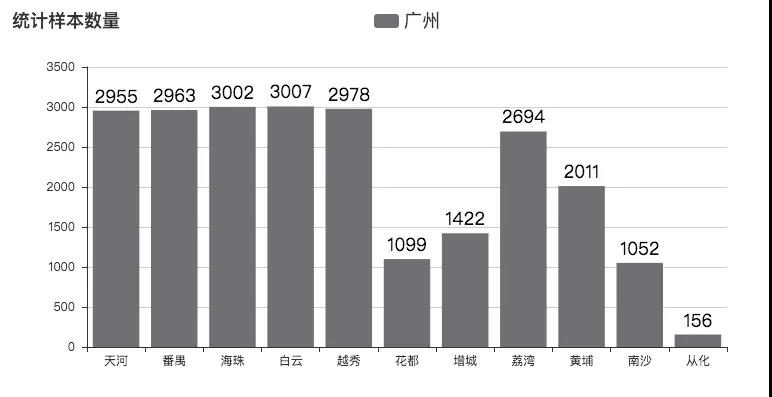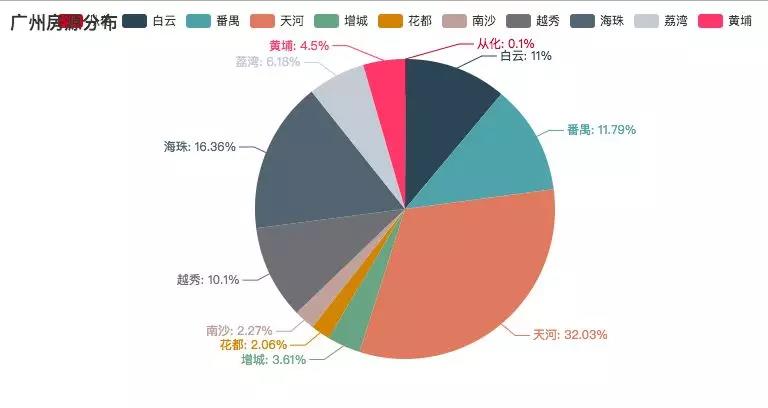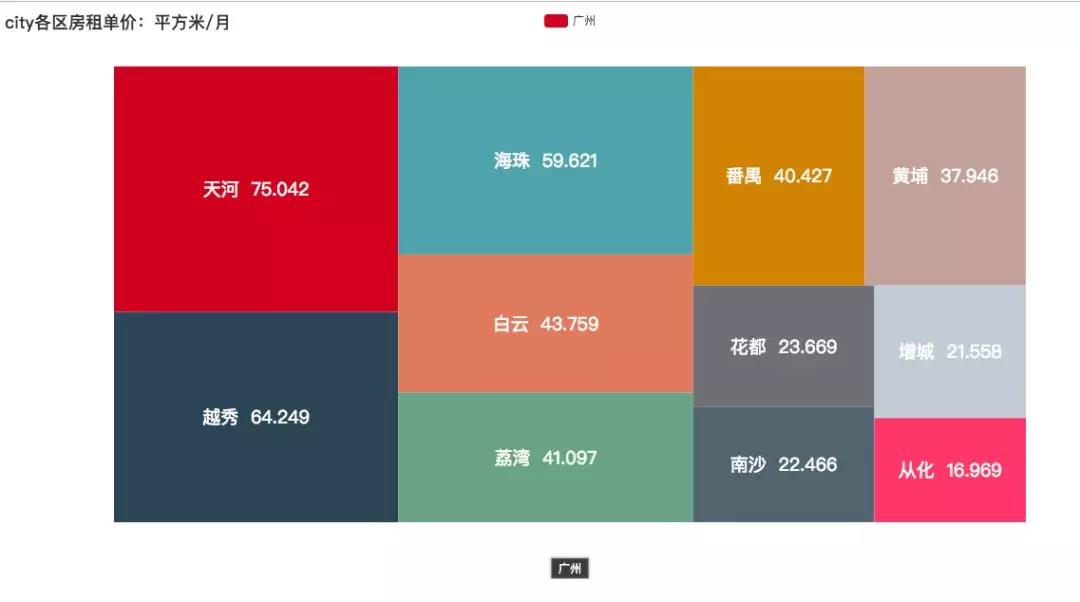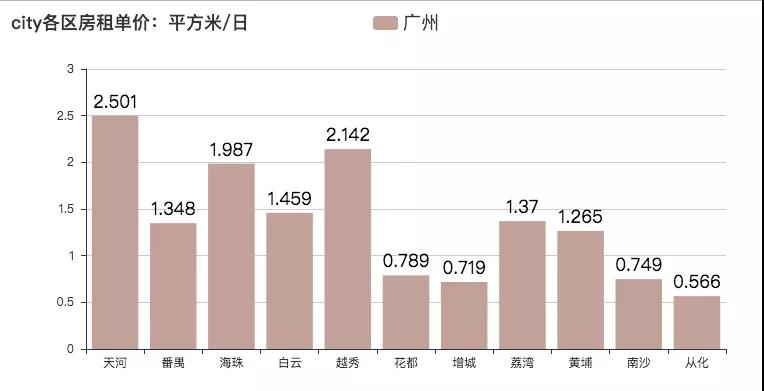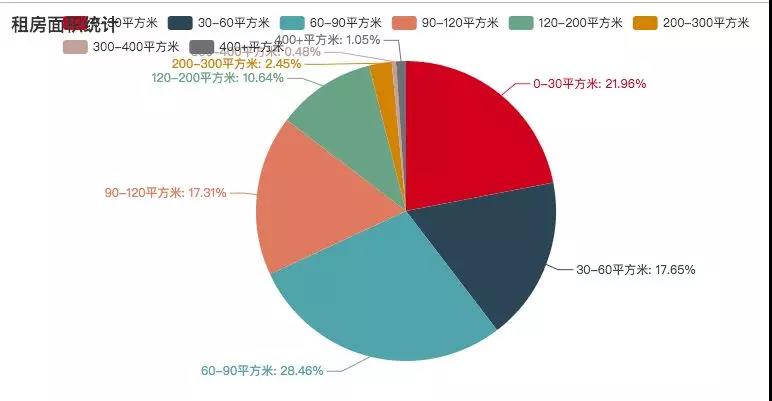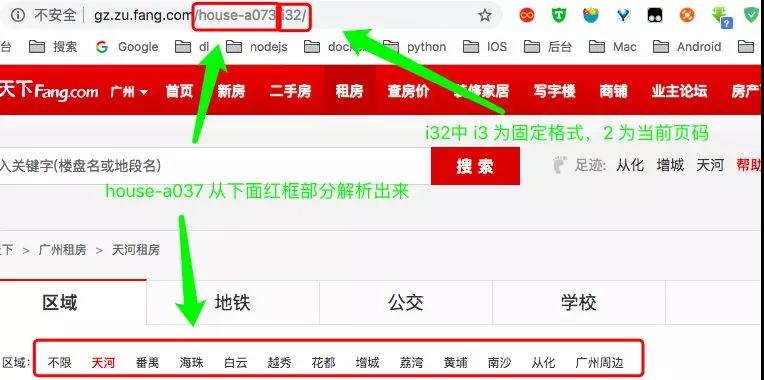爬取兩萬多租房數(shù)據(jù),告訴你廣州房租現(xiàn)狀
概述
- 前言
- 統(tǒng)計結(jié)果
- 爬蟲代碼實現(xiàn)
- 爬蟲分析實現(xiàn)
- 后記
前言
建議在看這篇文章之前,請看完這三篇文章,因為本文是依賴于前三篇文章的:
- 爬蟲利器初體驗(1)
- 聽說你的爬蟲又被封了?(2)
- 爬取數(shù)據(jù)不保存,就是耍流氓(3)
八月份的時候,由于腦洞大開,決定用 python 爬蟲爬取了深圳的租房數(shù)據(jù),并寫了文章《用Python告訴你深圳房租有多高》,文章得到了一致好評和眾多轉(zhuǎn)載。由于我本身的朋友圈大多都在廣州、深圳,因此,早就有挺多小伙伴叫我分析一下廣州的租房價格現(xiàn)狀,這不,文章就這樣在眾多呼聲中出爐了。然后,此次爬蟲技術(shù)也升級了,完善了更多細(xì)節(jié)。源碼值得細(xì)細(xì)探究。此次分析采集了廣州 11 個區(qū),23339 條數(shù)據(jù),如下圖:
其中后半部分地區(qū)數(shù)據(jù)量偏少,是由于該區(qū)房源確實不足。因此,此次調(diào)查也并非非常準(zhǔn)確,權(quán)且當(dāng)個娛樂項目,供大家觀賞。
統(tǒng)計結(jié)果
我們且先看統(tǒng)計結(jié)果,然后再看技術(shù)分析。
廣州房源分布:(按區(qū)劃分)
其中天河占據(jù)了大部分房源。但這塊地的房租可是不菲啊。
房租單價:(每月每平方米單價 -- 平均數(shù))
即是 1 平方米 1 個月的價格。方塊越大,代表價格越高。
可以看出天河、越秀、海珠都越過了 50 大關(guān),分別是 75.042 、64.249、59.621 ,是其他地區(qū)的幾倍。如果在天河租個 20 平方的房間:
- 75.042 x 20 = 1500.84
再來個兩百的水電、物業(yè):
- 1500.84 + 200 = 1700.84
我們按正常生活來算的話,每天早餐 10 塊,中午 15 塊,晚飯 15 塊:
- 1700.84 + 40 x 30 = 2900.84
那么平時的日常生活需要 2900.84 塊。
隔斷時間下個館子,每個月買些衣服,交通費,談個女朋友,與女朋友出去逛街,妥妥滴加個 2500
- 2900.84 + 2500 = 5400.84
給爸媽一人一千:
- 5200.84 + 2000 = 7200.84
月薪一萬還是有點存款的,比深圳好一點,但是可能廣州的薪資就沒深圳那么高了。
房租單價:(每日每平方米單價 -- 平均數(shù))
即是 1 平方米 1 天的價格。
哈哈,感受一下***的感覺。[捂臉]
戶型
戶型主要以 3 室 2 廳與 2 室 2 廳為主。與小伙伴抱團(tuán)租房是***的選擇了,不然與不認(rèn)識的人一起合租,可能會發(fā)生一系列讓你不舒服的事情。字體越大,代表戶型數(shù)量越多。
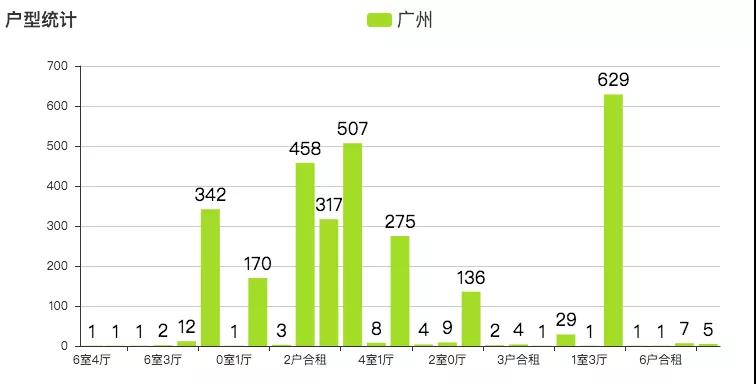
租房面積統(tǒng)計
其中 30 - 90 平方米的租房占大多數(shù),如今之計,也只能是幾個小伙伴一起租房,抱團(tuán)取暖了。
租房描述詞云
這是爬取的租房描述,其中字體越大,標(biāo)識出現(xiàn)的次數(shù)越多。其中【住家、全套、豪華、齊全】占據(jù)了很大的部分,說明配套設(shè)施都是挺齊全的。
爬蟲技術(shù)分析
- 請求庫:scrapy、requests
- HTML 解析:BeautifulSoup
- 詞云:wordcloud
- 數(shù)據(jù)可視化:pyecharts
- 數(shù)據(jù)庫:MongoDB
- 數(shù)據(jù)庫連接:pymongo
爬蟲代碼實現(xiàn)
跟上一篇文章不一樣,這是使用了 scrapy 爬蟲框架來爬取數(shù)據(jù),各個方面也進(jìn)行了優(yōu)化,例如:自動生成各個頁面的地址。
由于房某下各個區(qū)域的首頁地址和首頁以外的地址的形式是不一樣的,但是又一定的規(guī)律,所以需要拼接各個部分的地址。
首頁地址案例:
- # ***頁
- http://gz.zu.fang.com/house-a073/
非首頁地址:
- # 第二頁
- http://gz.zu.fang.com/house-a073/i32/
- # 第三頁
- http://gz.zu.fang.com/house-a073/i33/
- # 第四頁
- http://gz.zu.fang.com/house-a073/i34/
先解析首頁 url
- def head_url_callback(self, response):
- soup = BeautifulSoup(response.body, "html5lib")
- dl = soup.find_all("dl", attrs={"id": "rentid_D04_01"}) # 獲取各地區(qū)的 url 地址的 dl 標(biāo)簽
- my_as = dl[0].find_all("a") # 獲取 dl 標(biāo)簽中所有的 a 標(biāo)簽,
- for my_a in my_as:
- if my_a.text == "不限": # 不限地區(qū)的,特殊處理
- self.headUrlList.append(self.baseUrl)
- self.allUrlList.append(self.baseUrl)
- continue
- if "周邊" in my_a.text: # 清除周邊地區(qū)的數(shù)據(jù)
- continue
- # print(my_a["href"])
- # print(my_a.text)
- self.allUrlList.append(self.baseUrl + my_a["href"])
- self.headUrlList.append(self.baseUrl + my_a["href"])
- print(self.allUrlList)
- url = self.headUrlList.pop(0)
- yield Request(url, callback=self.all_url_callback, dont_filter=True)
再解析非首頁 url
這里先獲取到各個地區(qū)一共有多少頁,才能拼接具體的頁面地址。
- 再根據(jù)頭部 url 拼接其他頁碼的url
- ef all_url_callback(self, response): # 解析并拼接所有需要爬取的 url 地址
- soup = BeautifulSoup(response.body, "html5lib")
- div = soup.find_all("div", attrs={"id": "rentid_D10_01"}) # 獲取各地區(qū)的 url 地址的 dl 標(biāo)簽
- span = div[0].find_all("span") # 獲取 dl 標(biāo)簽中所有的 span 標(biāo)簽,
- span_text = span[0].text
- for index in range(int(span_text[1:len(span_text) - 1])):
- if index == 0:
- pass
- # self.allUrlList.append(self.baseUrl + my_a["href"])
- else:
- if self.baseUrl == response.url:
- self.allUrlList.append(response.url + "house/i3" + str(index + 1) + "/")
- continue
- self.allUrlList.append(response.url + "i3" + str(index + 1) + "/")
- if len(self.headUrlList) == 0:
- url = self.allUrlList.pop(0)
- yield Request(url, callback=self.parse, dont_filter=True)
- else:
- url = self.headUrlList.pop(0)
- yield Request(url, callback=self.all_url_callback, dont_filter=True)
***解析一個頁面的數(shù)據(jù)
- def parse(self, response): # 解析一個頁面的數(shù)據(jù)
- self.logger.info("==========================")
- soup = BeautifulSoup(response.body, "html5lib")
- divs = soup.find_all("dd", attrs={"class": "info rel"}) # 獲取需要爬取得 div
- for div in divs:
- ps = div.find_all("p")
- try: # 捕獲異常,因為頁面中有些數(shù)據(jù)沒有被填寫完整,或者被插入了一條廣告,則會沒有相應(yīng)的標(biāo)簽,所以會報錯
- for index, p in enumerate(ps): # 從源碼中可以看出,每一條 p 標(biāo)簽都有我們想要的信息,故在此遍歷 p 標(biāo)簽,
- text = p.text.strip()
- print(text) # 輸出看看是否為我們想要的信息
- roomMsg = ps[1].text.split("|")
- area = roomMsg[2].strip()[:len(roomMsg[2]) - 1]
- item = RenthousescrapyItem()
- item["title"] = ps[0].text.strip()
- item["rooms"] = roomMsg[1].strip()
- item["area"] = int(float(area))
- item["price"] = int(ps[len(ps) - 1].text.strip()[:len(ps[len(ps) - 1].text.strip()) - 3])
- item["address"] = ps[2].text.strip()
- item["traffic"] = ps[3].text.strip()
- if (self.baseUrl+"house/") in response.url: # 對不限區(qū)域的地方進(jìn)行區(qū)分
- item["region"] = "不限"
- else:
- item["region"] = ps[2].text.strip()[:2]
- item["direction"] = roomMsg[3].strip()
- print(item)
- yield item
- except:
- print("糟糕,出現(xiàn) exception")
- continue
- if len(self.allUrlList) != 0:
- url = self.allUrlList.pop(0)
- yield Request(url, callback=self.parse, dont_filter=True)
數(shù)據(jù)分析實現(xiàn)
這里主要通過 pymongo 的一些聚合運算來進(jìn)行統(tǒng)計,再結(jié)合相關(guān)的圖標(biāo)庫,來進(jìn)行數(shù)據(jù)的展示。
數(shù)據(jù)分析:
- # 求一個區(qū)的房租單價(平方米/元)
- def getAvgPrice(self, region):
- areaPinYin = self.getPinyin(region=region)
- collection = self.zfdb[areaPinYin]
- totalPrice = collection.aggregate([{'$group': {'_id': '$region', 'total_price': {'$sum': '$price'}}}])
- totalArea = collection.aggregate([{'$group': {'_id': '$region', 'total_area': {'$sum': '$area'}}}])
- totalPrice2 = list(totalPrice)[0]["total_price"]
- totalArea2 = list(totalArea)[0]["total_area"]
- return totalPrice2 / totalArea2
- # 獲取各個區(qū) 每個月一平方米需要多少錢
- def getTotalAvgPrice(self):
- totalAvgPriceList = []
- totalAvgPriceDirList = []
- for index, region in enumerate(self.getAreaList()):
- avgPrice = self.getAvgPrice(region)
- totalAvgPriceList.append(round(avgPrice, 3))
- totalAvgPriceDirList.append({"value": round(avgPrice, 3), "name": region + " " + str(round(avgPrice, 3))})
- return totalAvgPriceDirList
- # 獲取各個區(qū) 每一天一平方米需要多少錢
- def getTotalAvgPricePerDay(self):
- totalAvgPriceList = []
- for index, region in enumerate(self.getAreaList()):
- avgPrice = self.getAvgPrice(region)
- totalAvgPriceList.append(round(avgPrice / 30, 3))
- return (self.getAreaList(), totalAvgPriceList)
- # 獲取各區(qū)統(tǒng)計樣本數(shù)量
- def getAnalycisNum(self):
- analycisList = []
- for index, region in enumerate(self.getAreaList()):
- collection = self.zfdb[self.pinyinDir[region]]
- print(region)
- totalNum = collection.aggregate([{'$group': {'_id': '', 'total_num': {'$sum': 1}}}])
- totalNum2 = list(totalNum)[0]["total_num"]
- analycisList.append(totalNum2)
- return (self.getAreaList(), analycisList)
- # 獲取各個區(qū)的房源比重
- def getAreaWeight(self):
- result = self.zfdb.rent.aggregate([{'$group': {'_id': '$region', 'weight': {'$sum': 1}}}])
- areaName = []
- areaWeight = []
- for item in result:
- if item["_id"] in self.getAreaList():
- areaWeight.append(item["weight"])
- areaName.append(item["_id"])
- print(item["_id"])
- print(item["weight"])
- # print(type(item))
- return (areaName, areaWeight)
- # 獲取 title 數(shù)據(jù),用于構(gòu)建詞云
- def getTitle(self):
- collection = self.zfdb["rent"]
- queryArgs = {}
- projectionFields = {'_id': False, 'title': True} # 用字典指定需要的字段
- searchRes = collection.find(queryArgs, projection=projectionFields).limit(1000)
- content = ''
- for result in searchRes:
- print(result["title"])
- content += result["title"]
- return content
- # 獲取戶型數(shù)據(jù)(例如:3 室 2 廳)
- def getRooms(self):
- results = self.zfdb.rent.aggregate([{'$group': {'_id': '$rooms', 'weight': {'$sum': 1}}}])
- roomList = []
- weightList = []
- for result in results:
- roomList.append(result["_id"])
- weightList.append(result["weight"])
- # print(list(result))
- return (roomList, weightList)
- # 獲取租房面積
- def getAcreage(self):
- results0_30 = self.zfdb.rent.aggregate([
- {'$match': {'area': {'$gt': 0, '$lte': 30}}},
- {'$group': {'_id': '', 'count': {'$sum': 1}}}
- ])
- results30_60 = self.zfdb.rent.aggregate([
- {'$match': {'area': {'$gt': 30, '$lte': 60}}},
- {'$group': {'_id': '', 'count': {'$sum': 1}}}
- ])
- results60_90 = self.zfdb.rent.aggregate([
- {'$match': {'area': {'$gt': 60, '$lte': 90}}},
- {'$group': {'_id': '', 'count': {'$sum': 1}}}
- ])
- results90_120 = self.zfdb.rent.aggregate([
- {'$match': {'area': {'$gt': 90, '$lte': 120}}},
- {'$group': {'_id': '', 'count': {'$sum': 1}}}
- ])
- results120_200 = self.zfdb.rent.aggregate([
- {'$match': {'area': {'$gt': 120, '$lte': 200}}},
- {'$group': {'_id': '', 'count': {'$sum': 1}}}
- ])
- results200_300 = self.zfdb.rent.aggregate([
- {'$match': {'area': {'$gt': 200, '$lte': 300}}},
- {'$group': {'_id': '', 'count': {'$sum': 1}}}
- ])
- results300_400 = self.zfdb.rent.aggregate([
- {'$match': {'area': {'$gt': 300, '$lte': 400}}},
- {'$group': {'_id': '', 'count': {'$sum': 1}}}
- ])
- results400_10000 = self.zfdb.rent.aggregate([
- {'$match': {'area': {'$gt': 300, '$lte': 10000}}},
- {'$group': {'_id': '', 'count': {'$sum': 1}}}
- ])
- results0_30_ = list(results0_30)[0]["count"]
- results30_60_ = list(results30_60)[0]["count"]
- results60_90_ = list(results60_90)[0]["count"]
- results90_120_ = list(results90_120)[0]["count"]
- results120_200_ = list(results120_200)[0]["count"]
- results200_300_ = list(results200_300)[0]["count"]
- results300_400_ = list(results300_400)[0]["count"]
- results400_10000_ = list(results400_10000)[0]["count"]
- attr = ["0-30平方米", "30-60平方米", "60-90平方米", "90-120平方米", "120-200平方米", "200-300平方米", "300-400平方米", "400+平方米"]
- value = [
- results0_30_, results30_60_, results60_90_, results90_120_, results120_200_, results200_300_, results300_400_, results400_10000_
- ]
- return (attr, value)
數(shù)據(jù)展示:
- # 展示餅圖
- def showPie(self, title, attr, value):
- from pyecharts import Pie
- pie = Pie(title)
- pie.add("aa", attr, value, is_label_show=True)
- pie.render()
- # 展示矩形樹圖
- def showTreeMap(self, title, data):
- from pyecharts import TreeMap
- data = data
- treemap = TreeMap(title, width=1200, height=600)
- treemap.add("深圳", data, is_label_show=True, label_pos='inside', label_text_size=19)
- treemap.render()
- # 展示條形圖
- def showLine(self, title, attr, value):
- from pyecharts import Bar
- bar = Bar(title)
- bar.add("深圳", attr, value, is_convert=False, is_label_show=True, label_text_size=18, is_random=True,
- # xaxis_interval=0, xaxis_label_textsize=9,
- legend_text_size=18, label_text_color=["#000"])
- bar.render()
- # 展示詞云
- def showWorkCloud(self, content, image_filename, font_filename, out_filename):
- d = path.dirname(__name__)
- # content = open(path.join(d, filename), 'rb').read()
- # 基于TF-IDF算法的關(guān)鍵字抽取, topK返回頻率***的幾項, 默認(rèn)值為20, withWeight
- # 為是否返回關(guān)鍵字的權(quán)重
- tags = jieba.analyse.extract_tags(content, topK=100, withWeight=False)
- text = " ".join(tags)
- # 需要顯示的背景圖片
- img = imread(path.join(d, image_filename))
- # 指定中文字體, 不然會亂碼的
- wc = WordCloud(font_path=font_filename,
- background_color='black',
- # 詞云形狀,
- mask=img,
- # 允許***詞匯
- max_words=400,
- # ***號字體,如果不指定則為圖像高度
- max_font_size=100,
- # 畫布寬度和高度,如果設(shè)置了msak則不會生效
- # width=600,
- # height=400,
- margin=2,
- # 詞語水平擺放的頻率,默認(rèn)為0.9.即豎直擺放的頻率為0.1
- prefer_horizontal=0.9
- )
- wc.generate(text)
- img_color = ImageColorGenerator(img)
- plt.imshow(wc.recolor(color_func=img_color))
- plt.axis("off")
- plt.show()
- wc.to_file(path.join(d, out_filename))
- # 展示 pyecharts 的詞云
- def showPyechartsWordCloud(self, attr, value):
- from pyecharts import WordCloud
- wordcloud = WordCloud(width=1300, height=620)
- wordcloud.add("", attr, value, word_size_range=[20, 100])
- wordcloud.render()
后記
距離上一篇租房市場的分析已經(jīng)3、4 個月了,我的技術(shù)水平也得到了一定的提高。所以努力編碼才是成長的捷徑。***,應(yīng)對外界條件的變動,我們還是應(yīng)該提升自己的硬實力,這樣才能提升自己的生存能力。














